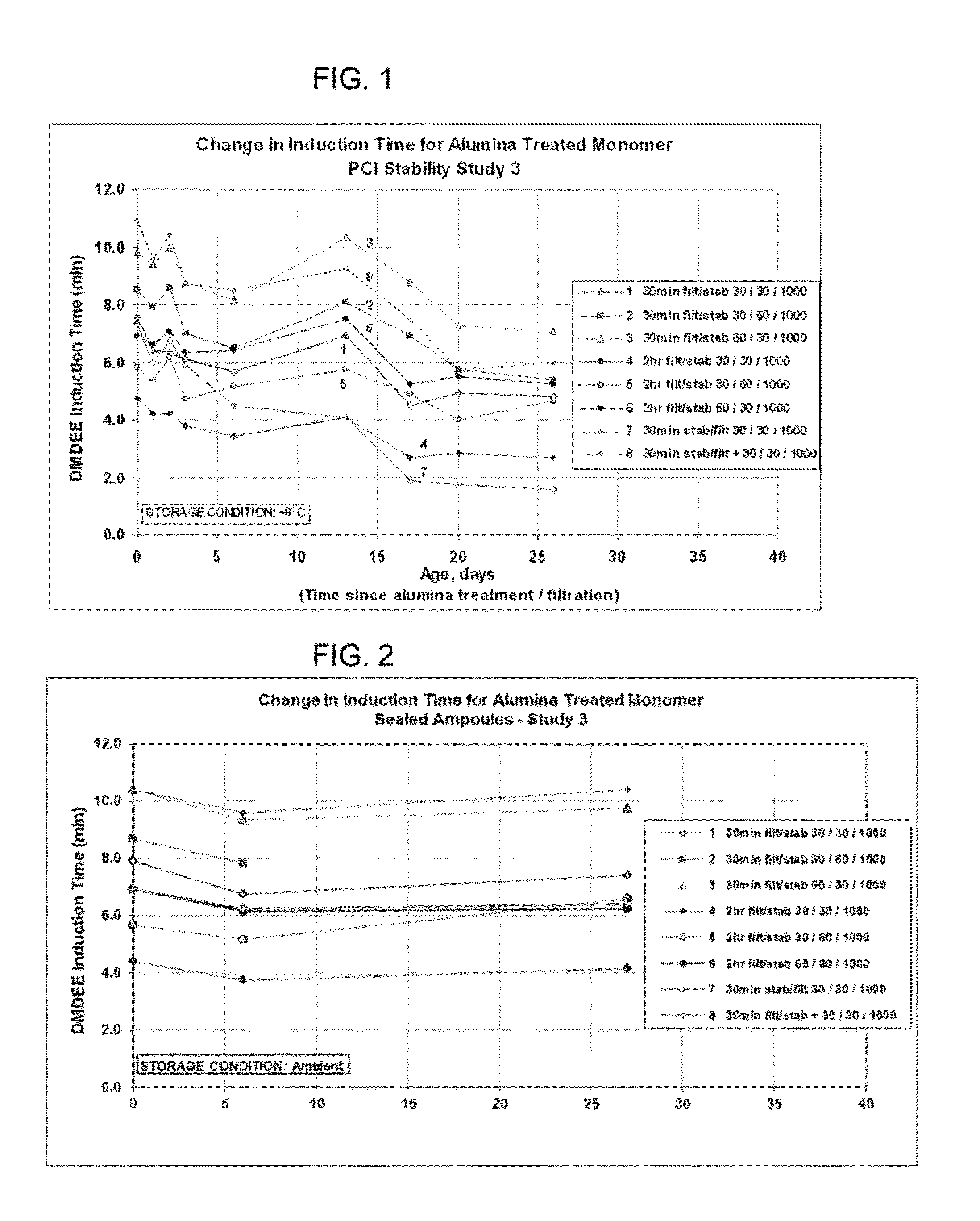1,1-disubstituted ethylene process
a technology of methylidene malonate and ethylene, which is applied in the direction of gaseous mixture working up, carboxylic acid amide separation/purification, separation process, etc., can solve the problems of limited commercial success, methylidene malonates continue to struggle, and 1,1-disubstituted ethylenes that have shown a lot of promise, etc., to achieve rapid and consistent or predictable cure speed, high yield and purity, and good shelf li
- Summary
- Abstract
- Description
- Claims
- Application Information
AI Technical Summary
Benefits of technology
Problems solved by technology
Method used
Image
Examples
examples
[0067]Having described the invention in general terms, Applicants now turn to the following non-limiting examples by which Applicants have demonstrated the utility and surprising benefit of the claimed process. Specifically, these examples demonstrate various processes in which a variety of alumina are used to treat various 1,1-disubstituted ethylene monomers under varying conditions. Further, these examples demonstrate the surprising attributes of the claimed processes, particularly with respect to the improved cure speed and consistent cure speed, enabling consistent and predictable results. Again, these examples are merely illustrative of the invention and are not intended to be or to be deemed limiting thereof. Those skilled in the art, having the benefit of this disclosure and the examples, will readily recognize many variations that may be applied and used in practicing the claimed invention and which are and are intended to be within the spirit of the invention and scope of t...
example 2
[0077]Neutral Alumina (WN-3) was used to treat two different monomers A-1 and A-2, both of which had low activity. The level of treatment was 6.5 weight percent (65 mg / g) alumina. Following alumina treatment portions of each of the samples, as well as untreated samples, were sealed in an ampoule. DMDEE testing was conducted immediately following sealing and again after 4 days storage at room temperature. Untreated Monomer A-1 had an induction time of ˜19 minutes whereas untreated Monomer A-2 had an induction time of ˜48 minutes. Treatment with alumina reduced the induction time to ˜4.5 minutes in all cases. These results indicate that the improved cure speed is retained, even following sealing in ampoule.
examples 3-7
[0078]A series of tests were conducted using three different batches of monomer, Monomer A-1, A-1(3) and A-2 and the neutral alumina from Example 1 but varying the amount of alumina, the temperature, and the contact time. The experimental details and results are shown in Table 2
TABLE 2Neutral AluminaContact time / Induction TimeExampleMonomer(mg / g monomerTemperature(minutes)C1A-1NoneN / A19.0E3A-130 5 min. / 25° C.16.1E4A-1120 5 min. / 25° C.13.6E5A-1120120 min. / 50° C.2.7C2A-1(3)NoneN / A>30E6A-1(3)120120 min / 50° C.2.2C3A-2NoneN / A>30E7A-2120120 min / 50° C.3.1
[0079]The results shown in Table 2 for the controls are indicative that the problem with cure speed is a general one and not a batch specific issue. Furthermore, and more importantly, these results show that alumina treatment provides a consistent, repeatable improvement in cure speed, even from batch to batch, as compared to the controls. This improvement was especially remarkable for examples E5-E7 where a longer exposure time and higher...
PUM
| Property | Measurement | Unit |
|---|---|---|
| Temperature | aaaaa | aaaaa |
| Temperature | aaaaa | aaaaa |
| Temperature | aaaaa | aaaaa |
Abstract
Description
Claims
Application Information
 Login to View More
Login to View More - R&D
- Intellectual Property
- Life Sciences
- Materials
- Tech Scout
- Unparalleled Data Quality
- Higher Quality Content
- 60% Fewer Hallucinations
Browse by: Latest US Patents, China's latest patents, Technical Efficacy Thesaurus, Application Domain, Technology Topic, Popular Technical Reports.
© 2025 PatSnap. All rights reserved.Legal|Privacy policy|Modern Slavery Act Transparency Statement|Sitemap|About US| Contact US: help@patsnap.com



